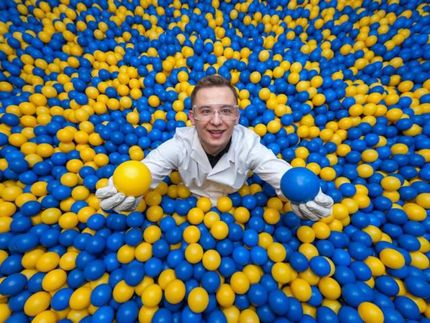Micromuscles: Micrometer-Sized Actuators from Liquid-crystal Elastomers
To move your arm or leg, certain muscles need to change shape, to either lengthen or contract. Now scientists have made liquid-crystalline particles that can change shape in a similar way, but which are only micrometers across. Professor Rudolf Zentel and his colleagues at the Universities of Mainz and Strasbourg have prepared these tiny shape-changing materials out of elasticized liquid crystals, taking advantage of a continuous fluidic device for fabrication.
When liquid crystals line up in certain ways, amazing properties can result. In the case of Prof. Zentel’s particles, the trigger, in this case heat, causes massive one-dimensional elongation and the round particles of weakly connected liquid crystals become stretched, increasing their length by up to 70%. As in healthy muscles, this elongation is fully reversible. The shape-change or actuating phenomenon in liquid-crystalline elastomers is well known to scientists, but the ability to produce these materials on a very small scale has eluded researchers until now.
The key to this recent work published in Advanced Materials is the use of a tiny processing unit called a microfluidic device. The device used allows continuous flows of ingredients into tiny tubes where they are mixed, with a non-stop stream of products coming out the end. Prof. Zentel and his co-workers claim that the constant current carrying the materials in the tubes when the particles are forming causes the liquid-crystal units to line up in just the right way to allow this shape-change property. Careful selection of materials, and heating the device to control the liquid-crystal phase, enables the researchers to produce spherical particles of the same size. By varying the reaction conditions, different sizes of particles can be made, with different capacities for changing shape. And, of course, the non-stop nature of the method is a bonus for potential manufacturers.
These “micromuscles” could soon have a real application. Prof. Zentel’s group is investigating the possible use of the particles as valves in tiny analytical devices called lab-on-a-chip systems. They also see the particles as presenting “a serious alternative to other microscopic actuation systems, like piezoceramics and hydrogel particles” due to their ability to both induce high strains and change shape quickly. “The possibility of producing liquid-crystal elastomer particles at high throughput in combination with their monodispersity allows for their large-scale use in the actuation of small objects in micromechanics, microfluidics, and robotics.”
Original publication: C. Ohm, C. Serra, and R. Zentel, "A Continuous-Flow Synthesis of Micrometer-Sized Actuators from Liquid-Crystalline Elastomers", Advanced Materials 2009.
Most read news
Topics
Organizations
Related link
Other news from the department science

Get the chemical industry in your inbox
From now on, don't miss a thing: Our newsletter for the chemical industry, analytics, lab technology and process engineering brings you up to date every Tuesday and Thursday. The latest industry news, product highlights and innovations - compact and easy to understand in your inbox. Researched by us so you don't have to.


























































